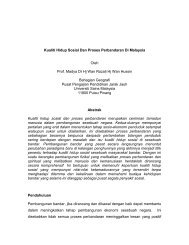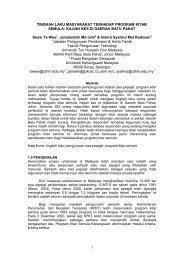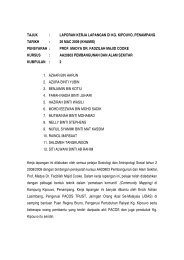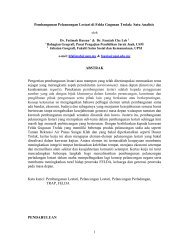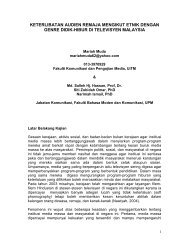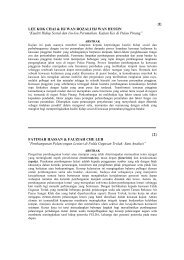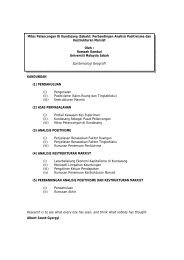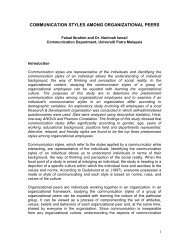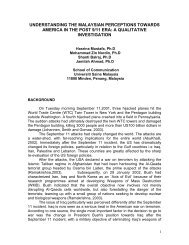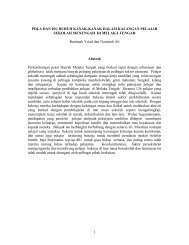FACTORS AFFECTING ONLINE PURCHASING BEHAVIOR
FACTORS AFFECTING ONLINE PURCHASING BEHAVIOR
FACTORS AFFECTING ONLINE PURCHASING BEHAVIOR
Create successful ePaper yourself
Turn your PDF publications into a flip-book with our unique Google optimized e-Paper software.
2relationship between marketer and consumers. Thus, transforming them into amore sophisticated, well-informed and savvy buyers and as suggested by Arens(1999) consumers today are becoming “active controllers “ of the messages theysee and hear. Apparently, these past few years have also witnessed the rise andrapid growth in economic importance of a group of consumers whose attitudes,aspirations and purchasing patterns are unlike any before them. Today, they arethe new consumers. They are already a potent force in the developed world, andwithin the next decade will probably dominate consumption in all parts of theworld. This new consumers with their distinctive style of consumption differs intheir purchasing decisions from that of the old consumers.These past centuries has seen the spread of industrial production and anemphasis on material consumption. Historically, the consumer revolutionoccurred in certain areas of Western Europe at different times. Numeroustheorists have addressed the issues regarding the origin and spread of consumerculture. However, they vary in their interpretation of the role of consumerideology in capitalism and the specific time as well as place for the rise ofconsumer culture. According to Mukerji (1983), the development of capitalismstarted circa 16 th and 17 th centuries in the Netherlands. Yet, Campbell (1987)and McKendrik et al. (1982) suggested that the original site of consumer culturewas England during the 18 th century. However, O’Guinn et al. (2003) noted thateven though consumer culture was already advancing prior to the periodbetween 1875– 1918, yet it was deemed that during this age that consumerculture really took hold and the rise of modern advertising also had a lot to dowith it. In fact the violent wave of the development in the field of advertising hasalso been said to alter the situation. Thus, breaking the union of production andconsumption to split between the producers from the consumer and eventuallytransformed the consumer culture (Toffler 1980).Clearly, the society that we live in today is highly consumptive. We consumemass produced commodities in abundance. It is only appropriate to suggest thatwe buy to fulfill our needs both basic and the not-so basic. Hence, we areconsumer society that buys, use and discard to survive. However, in the pastone hundred years, the phenomenon of mass consumption emerged where hugenumbers of people consume a variety of relatively cheap, industrially-producedproducts. A significant change in the socio-economic order occurred andconsumption becomes, “the idiom of daily life.” Mass consumption has radicallychanged the understandings, expectations, as well as mechanics of society(http://www.peak.sfu.ca/cmass/issue2/ads.html) and today we are seeing theInternet as a powerful business tool that has transformed the dynamics of manysocial and commercials interactions. The barriers that have too oftenaccompanied traditional commerce are giving way to new business approaches.Consumers, producers and distributors can now have access to flexible, fast andinexpensive ways of participating in the global marketplace.
3The Internet has affected the way the world do business by altering the basicbusiness dynamics. The dynamics that have shaped economic practices sincethe early nineteenth century are being replaced by a new set of fundamentalprinciple based on the new digital economy. The Internet has also helpedincreased global exposure for both businesses and consumers alike. Domesticcompanies expand internationally just by going online and investing in e-business. At the time consumers can also expand their shopping horizons byusing the Internet to search for the best deals and expose themselves to e-retailers from around the globe.Obviously, the Internet has offer tremendous new opportunities to businessesregardless of their size. As a medium, it is equally accessible to both the large aswell as the small operators. This has thus, resulted in local and internationalmarketplace. The Internet is changing the way advertisers present, sell, andcommunicate with consumers. Today, a variety of practices are being used toreach consumers.Clearly, the Internet has both supported the advertising and also relies onadvertising for its own success. Today, consumers worldwide can shop online 24hours and some market sectors such as insurance, financial services, computerhardware and software, travel, books, music-video, flowers as well asautomobiles are experiencing rapid growth in online sales(www.ms.com/insight/misc/inetretail.html)New consumers transcend all ages, ethnic groups and to some extent, income.They can be found among the affluent over-fifties as in the case of developedcountries or they can also be among the ambitious under-thirties. Initially, whenthey first emerged in the marketplace, new consumers were predominantly male,however today as more women gain better economic power both as wealthproducers and consumer decision makers, they are now equally likely to be ofeither sex. Living in economies where their basic needs are quickly and easilysatisfied, New Consumers becomes more concerned to satisfy their wants, whichfrequently focus on original, innovative and distinctive products and services.Thus, they tend to reject mass-produced and mass-marketed commodities.The New Consumers were born into a society that was slowly moving away fromyears of austerity that was initially caused by the great depression of the 1920sand early 1930s and subsequently, by the second world war (Lewis & Bridger2003). These New Consumers are independent, individualist, involved and wellinformedon consumer matters. These New Consumers are already rated assignificant players in an increasingly fragmented and fragmenting marketplace.There appears to be a number of different ways to classify consumer groups interms of lifestyle depending upon the unique set of defining events that tookplace during the formative years of a person’s life, their current circumstances,their education and their country.
4A Roper Starch survey of consumers around the world has identified six valuesegments among consumers namely, Strivers who comprised 23% of theworld’s adult population and are prominent in the developed and developingnations of Asia. Material things are important to these consumers and they havelittle time for any media except newspapers. Then there are the Devouts thatcomprised 22% of the world’s adult population and are concentrated in Africa,Asia and the Middle East. These consumers have more traditional values suchas faith, duty, and obedience. They are least likely to be involved with the mediaand least likely to want western brands.The Altruists comprised 18% of the world’s adult population. They are outfocused,interested in social issues, and generally found in Latin America andRussia. Intimates make up 15% of the adult population worldwide. They focuson relationships, are involved with their homes and are found most often inBritain, Hungary, Netherlands and the U.S. Fun Seekers make up 12% of theadult population worldwide. They are the youngest group, and espouse values ofpleasure, excitement, and good looks. They are more global in their lifestyle, likemusic, and are part of the MTV generation. The last segment is the Creativeswho are 10% of the adult population worldwide and are dedicated to learning,knowledge, and technology. They are global trendsetters in adopting new media(Schuster 2004). It is essential that marketers have an understanding of thefragmentation of consumer groups. For such is critical in developing anintegrated marketing communication campaign.Currently, the consumer market with the most potential for growth is Asia(Schuster 2004) and the past 50 years saw all of Asia undergoing major changes.However, the transition is not yet complete. The Chinese people in the People’sRepublic of China constitute a large market, the Chinese diaspora in the rest ofAsia is even a larger market. GDP per capita varies from a low US $ 155 inMyanmar to US $990 in the Philippines to US $ 4,016 in Malaysia to a high of US$ 25,864 in Singapore (Selected ASEAN Indicators 2000, ASEAN Statistics,Association of Southeast Asian Nations , www.aseansec.org. Nov 13, 2001).The growth and expansion of the Internet technology has revolutionized the basicbusiness dynamics. This has thus, form a new paradigm that allows consumers,producers and distributors access to flexible, fast and inexpensive ways ofparticipating in the global marketplace. The utilization of Internet in marketingprocess has also introduced cyber advertising (cyber ads). The emergence ofcyber ads in Malaysia can be traced from as early as circa 1998 when theMultimedia Super Corridor (MSC) project was launched on 27 June 1998(http://www.mdc.com.my/msc/index.html). With the inception of the MSC, therewas the widespread use of the Internet and this include conducting businesstransaction. However, during its nascent stage, cyber ads in the country wasnot advancing as rapidly as other developed countries, yet it was found thatcyber ads was affecting conventional ads (Norliza Ahmad, Berita Harian, 4 th July
52000). In fact several organizations were already actively involved in cyber ads.As such it is interesting to study the relationship between the cultural dimensionsand purchasing behavior through the cyber ads. This study suggests that thereis a significant relationship between cultural dimensions and purchasing behaviorthrough cyber ads. That leads to the following hypotheses.Internet advertising or cyber advertising (ads) is a form of advertising wherecompanies or organizations promote their products or services through the newmedium or the Internet (Belch & Belch 2004). Advertising on the Internet employsa variety of forms such as banners, sponsorships, pop-ups, interstitials. This newform of advertising has allowed companies to “push” their message to consumersinstead of waiting for consumers to locate them.Cyber advertising is becoming an important element in the Internet era. Asreported by Na Li and Ping Zhang (2002), online shopping has become the thirdmost popular Internet activity after e-mail using and web browsing. In fact, it wasconsidered more popular than browsing for entertainment and news. Onlineshopping behavior or also known as online buying behavior and Internetshopping refers to the process of purchasing products or services via the Internet.Past research has shown a similar pattern, according to the Pew ResearchCenter, 46 percent of Internet users use email everyday, and 36 percent of emailusers receive unwanted messages, 72 percent of which are sales solicitations(Witt, G.E. 1999.You’ve Got Spam. American Demographics. Sept. 22). Asreported by Korgaonkar and Wolin (2002), in the USA, 42.9 percent of allhouseholds or 45.9 million households are actively connected to the Web with 88million adults over the age of 18 surfing the Web. As such it is not at allsurprising that many companies are turning to the Web to advertise theirproducts or services.Indeed, the Internet has not only provides new ways for consumers to learnabout and acquire products and services online but has also reshape consumerbuying patterns. However, the figures are still very low. Apparently there havealso been extensive studies on online purchasing behavior in recent years.Internet users have not only used the Internet to research online purchases, butthey are also buying online albeit low in number.After a period of decline, online shopping is on the rise again. It was estimatedthat total US spending on online sales increased to US $ 5.7 billion in December
62001 from US $ 3.2 billion in June of2001(www.forrester.com/ER/Press/Release/0,1769,678,FF.html). By these sameestimates, the number of households shopping online increased to 18.7 million inDecember 2001 from 13.1 million in June 2001. Consumers spent an average ofUS $ 304 per person in December 2001, compared with US $ 247 in June 2001.Thus, this shows that online retail remained stable despite the social andeconomic instability and proved e-commerce is positioned to stand up to pooreconomy (www.forrester.com/ER/Press/Release/0,1769,636,00.html).Although the online advertising expenditure is still very low as compared to theused of the conventional media, yet as the Internet grows the online purchasingexpenditure is also increasing. It was reported that online retail trade was aboutUS $ 217.8 billion by 2000 and this account for 8 percent of total retail. By 2001,domestic online sales showed a total of more than US $ 53 billion a growth rateof about 20 percent compared to the year 2000(http://iml.jou.ufl.edu/projects/Fall02/Kim/Introduction.htm). It was reported thatan estimated US $ 167 million was spent on cyber ads in 2002. Cyber ads wasalso cited as a strongly performing media sector(http://www.nielsenmedia.com.au/industry.asp?industry ID=22). The US $ 167million in expenditure was reported in three broad advertising categories –general advertising, classified advertising and search and direction advertising.Obviously, the number of consumers who are purchasing online is growingsharply. The U.S. advertising market reported that the Internet showed the mostrobust year-over-year gain for 2004, posting US $ 24.5 billion, an increase to US$ 7.4 billion in ad spending as compared to 2003 (http://www.tnsmi.com/news/03082005.htm).Internet advertising spending has grown by overhalf in 2004, and it is expected to expand dramatically over the next year(http://www.e-consultancy.com/newsfeatures/156652). In Asia, computers,online booking and travel lead in cyber advertising retail with 28, 25, 11 percentrespectively of the total market (Kotler et al. 2003). Such low number in cyberads purchasing in Asia may be due to the fact that most Asian consumers arehybrid, they buy books from places like Kinokuniya and sometimes order booksfrom Amazon.com, smell the perfume and interact with salespeople. Furthermore Asians view shopping as a leisure activity for the family and as such madethe Internet less popular especially for products that must be touched orexamined in advance (Kotler 2003).Some Asian characteristics make Internet shopping unattractive. For example,Hong Kong with its compact urban geography, hardworking low population ofhousehold car ownership was thought to be suited for online grocery services.Thus, Admart was started. However, it closed down within 18 months. Severalreasons accounted for this, Hong Kongers are not used to buying in bulk. Livingspace in Hong Kong is so cramped that few people have the cupboard spaceneeded for bulk buying. Further, food shopping is an experience deeplyingrained in the Chinese culture where a maid or the wife is likely to visit the
7market twice a day so that both lunch and dinner will be made from the freshestingredients. People like to feel the food, touch it, and squeeze it (Kotler et. 2005).Similarly in Malaysia, Ray Cheng, 48, sets up a family greengrocers’ in USJ witha website in 2000. His intention was to become the first family ‘e-grocer,’unfortunately his business suffered after the dotcom crash of 2000. Chengdiscovered that Malaysians are still reluctant to transact online, especially sowhen it comes to buying food (Postill 2004). Another research conducted byUniversiti Teknologi Mara (UiTM) submitted to the Consumers International AsiaPacific found that 35 percent of Malaysian used the Internet, yet only three tofour percent had made transactions online (Berita Harian, 23 June 2005, pg 12).Although the growth and expansion of the Internet technology in Malaysia hasbeen said to revolutionized the basic business dynamics and has thus form anew paradigm allowing consumers, producers as well as distributors access toflexible, fast and inexpensive ways of participating in the global marketplace,however it was also found that cyber advertising in the country was notadvancing as rapidly as other developed countries (Berita Harian, 4 th July 2005).Appropriately, this study was conducted with the aim of examining the onlineshopping behavior in the country and specifically it aims to examine the possibledeterminants of cyber advertising purchases namely the personality variables(risk propensity and convenience), cultural dimensions (uncertainty avoidance,power distance and individualism/ collectivism), internet usage capability,internet usage to obtain product information, experience of internet usage,product characteristics and attitude toward internet advertising and purchasingthrough cyber advertising.Theories and Conceptual BackgroundThe study examined seven hypotheses based on the integration of Krugman’sLow Involvement Theory, Elaboration Likelihood Model (ELM) and Hofstede’sCultural Dimensions. Krugman (1965) incorporated the theory of lowinvolvement into advertising suggesting that information by consumers isdifferent in high consumer involvement situations as opposed to the lowinvolvementones. He has also noted that the process of receiving advertisinginformation by consumers is different in high consumer involvement situations asopposed to the low-involvement ones. As consumers are exposed to internetadvertisements, they develop an attitude toward the internet as an advertisingmedium. The more that a consumer accepts the internet as a legitimate mediumfor advertising, the more likely that consumer is to purchase good and servicesthrough cyber advertising. While Petty and Cacioppo’s (1986) ElaborationLikelihood Model, conceptualized that information processing and attitudinalchange depend on the amount and length of information processed. Hofstede’sCultural Dimensions have been found to affect the diffusion process of new
8innovations. Indeed many researchers have argued that cultures high onuncertainty avoidance are less likely to be early adopters of any innovation.ConceptualizationThe technology today has becomes more sophisticated and internet offers anunlimited marketplace to marketers. Billions of advertising messages travelalong the huge commercial networks that make up only part of the internet. Tothe consumers, the case for shopping on the internet is compelling. Consumerscan both save time by shopping at places that are internet access and also avoidcrowded shopping malls. However, online purchasing does not appeal to allconsumers. Studies showed that when it comes to online purchasing,personality variables play an important role in influencing consumers to purchaseonline. The two personality variables that will be discussed in this paper are riskpropensity and convenience.Risk propensityThe concept of risk is important for understanding how internet consumers makechoices. Individual faces risk when a decision, action, or behavior can lead todifferent possible outcomes (Bem 1980). Shopping environments on the internetmay be uncertain for the majority of online shoppers, especially if they arenovices. Online buyers may not be to physically inspect the product that theyintend to buy and this can be a drawback to the electronic business.Therefore, perceived risk can thus be considered a function of uncertainty aboutthe potential outcomes of a behavior and the possible unpleasantness of theseoutcomes (http://www.auburn.edu/~forsysa/NTC/archive.htm). When it is relatedto online shopping, the risk may then be defined as the subjectively-determinedexpectation of loss by an online purchaser in contemplating a particular onlinepurchase. Amongst the identified perceived risk are financial, productperformance, social, psychological and time/ convenience loss.Financial risk stems from paying more for a product than being necessary or notgetting enough value for the money spent (Roehl and Fesenmaier 1992). Whileperformance risk or quality risk referred to the belief that a product will notperform as well as expected or will nor provide the benefits desired (Bo-chiuan,Su 2003).Physical risk involves the potential threat to a consumer’s safety or physicalhealth and well-being. When a purchase made fails to reflect on its purchaser’sself-image or personality then that is considered as psychological risk. Whilesocial risk is concerned with an individual’s ego and the effect that will have onthe opinions of reference groups. Risk propensity can be defined as thefrequency with which people do or do not take different kinds of risks. It is also arisk taking behavior of an individual across time and situations. Based on the
9literature review, the following hypothesis incorporating the risk propensityvariables was proposed:Hypothesis 1:Hypothesis 2:Risk propensity is significantly related to the likelihood that aconsumer will make a purchase through cyber ads.Risk propensity is significantly related to the purchasingbehavior through cyber ads.ConvenienceThe online stores are open 24 hours a day and offering shopping convenience atlittle or no additional cost to the owner. This has thus facilitates shopping byanyone, anytime, anywhere in the world who is connected to the internet.Maignan and Lukas (1997) identified the internet as a medium that facilitates theconsumption of other goods and services.Local and international customers will benefit from companies offering shoppingconvenience. For instance an international customer from across the world whowants to look for a certain reference book can do so by logging-on to thewebsites in mid-day and order the book from companies such as Amazon.comwhile the U.S retailers are quietly asleep at night. The same user may beshopping from home, from work, or any other place that he/ she may haveaccess to the internet for further convenience.To consumers purchasing through cyber ads can be compelling. For instancethey can save time by shopping at a place where they have internet access andthey can also avoid crowded shopping malls. Based on the above discussion, thefollowing hypotheses were proposed:Hypothesis 3:Convenience variable is significantly related to the likelihoodthat a consumer will make a purchase through cyber ads.Hypothesis 4: Convenience variable is significantly related to thepurchasing behavior through cyber ads.Individualism/ Collectivism DimensionHofstede (1984) developed the individualism/ collectivism dimension to describethe relationship between the individual and the collectivity that is reflected in theway people live together. It is to emphasize the goals, needs and view of the ingroupover those of the individual or subjugating the individual’s goals, needsand views to group. This dimension encompasses the way in which the self andothers are regarded as well as the interaction between them. It reflects theextent to which a society regards the individual as its most fundamental
10component and the degree of acceptance of an individual’s satisfaction of his orher own needs within collective groups.However in the collectivist societies the group is considered to be the mostfundamental component of society. In such societies, the individual’s rights aresecondary to those of group. According to the study of Hofstede (1984), theAsian culture is an example of a collectivistic nation where dependence is valuedand society expects the individual to subordinate his own needs to those of thegroup.Hypothesis 5:Individualism / collectivism dimensions is significantly relatedto the purchasing behavior through cyber ads.The Power distance dimensionPower distance measures the extent to which a society tolerates inequality ofpower in organizations and in society. In a high power distance society, hierarchyis strong and power is centralized at the top. Individuals are very conscious oftheir rank, and superiors and subordinates feel separate from each other. Koreafor example is of high power distance society just like most of the other Asiancountries (Schutte & Ciarlante 2000).Darley and Luethge (2003) refers to power distance as the acceptance ofinequality in power and authority between individuals in a society. Whileinequality may exist within any culture however the degree to which it is acceptedvaries considerably across cultures. Therefore, individuals who come fromcultures exhibiting high power distances such as Malaysia, Egypt, India, Nigeria,Saudi Arabia and Venezuela (Hofstede 1991) might be expected to respond insocially desirable ways designed to please those in higher positions of power,stressing coercive, established and referent power (Simon 2001).Hypothesis 6:Power Distance dimension is significantly related to thepurchasing behavior through cyber ads.Uncertainty Avoidance dimensionThe third dimension chosen for this study is the uncertainty avoidance. This itemreflects a culture’s tolerance or intolerance of uncertainty. In a high uncertaintyavoidance culture, uncertain, ambiguous, risky or undefined situations areviewed as threatening and to be avoided at all costs. In order to avoid uncertaintyavoidance culture, risk is regarded as a natural component of life that can oftenproduce opportunity. Since individual are regarded as the engines of change,therefore they must take risks (Schutte & Ciarlante 2000). While Hofstede (1991)
11stressed that uncertainty avoidance is the extent to which the members of aculture feel threatened by uncertain or unknown situations.Cultures that are risk averse are also cultures that have low uncertaintyavoidance while those that are not risk averse tend to have high uncertaintyavoidance. In low uncertainty avoidance culture there is a tendency to acceptcalculated risk as necessary in order to seize opportunity. However, in a highuncertainty culture risk is regarded as threatening and to be avoided. In thestudy conducted by La Ferle (2002), Malaysia was found to be in the groups ofcountries that was the least risk averse.Hypothesis 7:Uncertainty Avoidance dimension is significantly related tothe purchasing behavior through cyber ads.MethodA survey was conducted in the middle of September 2004 and 504 completedquestionnaires were returned by early November 2004. A 12-pagesquestionnaires survey forms were distributed to respondents chosen throughsimple random sampling from amongst the Internet users from the Subang Jaya,Puchong and Kuala Lumpur areas. The sample is relatively homogenous interms of its demographics and thereby helps enhance internal validity.Appropriately the simple random sampling was chosen since the purpose of thestudy was to test the relationships among the variables (Calder, Phillips andTybout 1981). The questions consisted of both open-ended and close-endedquestions.The purchasing behavior through cyber ads was operationalized by asking threeinterrelated questions. The first question asked the respondents whether theyhad purchased goods or services from cyber ads in the previous six months, witha dichotomous “yes” or “no” as possible response. Two questions designed tocapture the Ringgit amount as well as the frequency of purchases made in thepast twelve months.The demographics information provided by the respondents included age,gender measured as either male of female, ethnic, education, and profession.The sample consisted of 53 per cent respondents between the age brackets of20 – 29 years old and the least number represented was form the age group of50 years and older. As reported by Kotler et al. (2005), in Malaysia, a consumerlifestyle segmentation by attitudes toward technology showed that the “e-savvy”segment comprises high proportion of young people in their 20s (29 percent). Infact many Internet surveys agreed that online population and purchasers arerelatively younger, more educated and wealthier (Bellman et al.1999). In terms
12of gender, the sample was almost evenly divided with the number of femalerespondents (56 percent) slightly higher than that of the males (44 percent). Amajority of the respondents are Malays (77 percent) with 14 percent Chinesefollowed by Indians and others with six and three percent respectively.The response rate of people that have finished upper secondary school is 13percent and lower secondary school is one percent. The respondents in thestudy were primarily involved in the educational field (20 percent), finance (14percent), computer (11 percent), advertising ( 3 percent), insurance (3 percent),telecommunications (2 percent) and various other professions (27 percent).Table 1 shows the detailed information of the profile of the respondents.Table 1:The demographic profile of the respondentsAge (n=497)20 - 2930 - 3940 - 4950 >Sex (n=497)MaleFemaleEthnic (n=497)MalayChineseIndianItems (%)53291444456771463A great number of respondents had a university degree or higher education witha bachelor and Master’s degree with 58 percent and 15 percent respectively. Thestudy shows that fact that this category of people was more familiar with the useof a personal computer, the internet and purchasing through cyber advertising.There is a possibility that they may have use the computer or internet for workrelated activities. There were only two percent of the respondents who havecompleted their Doctoral Degree and only 13 percent respondents who havecompleted their Upper Secondary level.
13Table 2: The demographic profile of the respondentsItems (%)Education (n=487)Lower secondary schoolUpper secondary schoolVocational/ Technical schoolBachelor degreeMaster’s degreeDoctoral degreeOthers (please specify)Profession (n=486)Banking/ FinanceAdvertising/ MarketingPublic RelationsComputers/ ElectronicsEducationInsuranceGovernment/ Public servicesTelecommunicationsOthers1133571538661511569712899131ANALYSIS AND RESULTSThe data from Table 3 indicate that most people are still not buying online orthrough cyber ads. The study found that only 13 percent of the respondentshave purchased good from the Internet through cyber ads. The number wasdefinitely small. However this is not surprising, as previous studies had alsoreported that online purchasing among Malaysians are indeed very low (BeritaHarian, 23 June 2005, Manju et al. 2003). This result is also not uncommon asproven by the research conducted by Donthu and Gracia (1999) who found thatfrom 790 successful interviews that were conducted, only 122 respondents (15percent) were cyber ads shoppers.Although e-commerce was introduced since the 1990s in Malaysia, yet onlinepurchasing is still developing in the country. This being a new practice will needtime for a full adoption process. There is also a possibility that cultural valuesmay be a factor affecting the adoption of purchasing online. As explained byHerbig and Miller (1991) cultures that exhibit large power distance will be lessinnovative and consequently as mentioned by Le Ferle et al. (2002), Malaysiawas ranked as having the most rigidity between superiors and subordinates andthis explained its large power distance. Therefore, there is a possibility that theunwilling to adopt the new online purchasing activity is impacted by the culturalvalues.
14It was also found that respondents were also unwilling to spend much online. Asshown from the Table 3, only 33 percent had spent between RM100 – RM400,while only 16 percent had spent more than RM800. Although some respondentsare already willing to make online transactions, however the amount of moneyspent online is still low. Data in Table 1 also indicate that a low 9 percent havespent between RM401 – RM600. It is apparent that consumers are still unwillingto spend much on online purchase of products or services and this can thus saidthat they were not willing to risk losing money on this new type of transactions.The study also shows that respondents are still considered lighter users of theWeb as they were shown to purchase lesser items. As mentioned byKorgaonkar and Wolin (2002) in terms of Web usage, the lighter users tend topurchase lesser items as compared to the heavier users.When it comes to the frequency of the transactions made, a majority of 34percent reported that they have made transactions less than once per month. 24percent said that they had made transactions between 2 – 5 times while 22percent had transacted 1 – 2 times/ month. The study also showed that therespondents who have made more than 10 transactions were still very low (3percent). Clearly, suggesting that purchasing through cyber ads is still unpopularamongst Internet users and since nearly half of the respondents have onlypurchased less than once a month therefore they can be categorized asoccasional buyers. (http://iml.jou.ufl.edu/projects/Fall02/Kim/measurement.htm)Table 3: Purchasing through cyber adsItemPercentIn the past six months, have you ever purchased products orservices through the cyber ads ? (n=504)13How much would you estimate you have spent with theInternet retailer in the past twelve months (n=63)Less than RM100RM101 – RM400RM401 - RM600RM601 - RM800More than RM800323391016How often have you transacted with the Internet retailer in thepast twelve months ? (n=63)Never 14
15Less than once/ month1 - 2 times/ month2 - 5 times/ month6 - 9 times/ month> 10 times/ month34222433What are people buying through cyber ads? The survey asked respondents toindicate the purchase of items from different product/ services categories withinthe last six months. The data (Table 3) indicate that most people are not yetbuying online. The most popular transactions occurred in the e-banking serviceswith 80 percent respondents reported to have used the service. 65 percent havebought books online, 63 percent bought flowers while 50 percent hadexperienced buying household items. The least purchased category was cars(10 percent). This could be also due to the fact that cars are luxury andexpensive items. It is also a high-involvement product and as noted by Na Li andPing Zang (2002) product involvement affect consumers’ online shoppingattitudes and behavior.While their purchasing activity is not as high, interestingly data shown in Figure 1indicate that respondents had purchased various products such as food (46percent), cosmetics (41 percent), computer equipment (40 percent), homefurnishing (39 percent), fast food (33 percent), fashion apparel (33 percent),jewelry (31 percent), CDs (32 percent), luxury watch (27 percent), shampoos (25percent), house (24 percent) and using the financial services (44 percent).Past studies also showed that consumers who frequently engaged in onlinepurchasing more often purchased books, computer products, electronic goods,entertainment and internet-related products (Kwak et al. 2002). These areconsidered high-involvement products and as suggested by Yoon and Kim(2001), the Internet is a medium better suited for high-involved products.The diagram below is an adaptation from the FCB Planning Model (Belch &Belch 2004) and it provides a brief explanation of what respondents hadpurchased from the Internet. As shown in the figure the products/ services thathad received high percentage in terms of the products/ services that werepurchased were from the high-involvement cognitive grid of the model. Products/services such as e-banking, books, financial services, computer equipment,house furnishing, house and autos are categorized as high-involvement cognitiveproducts/ services. While such products like jewelry, cosmetics, fashion apparel,luxury watch and CDs are considered as high-involvement affective products.The figure indicates that products such as food, fast food, household items andshampoos are categorized as low-involvement habit formation products. One ofthe products included in the study was flowers and it is categorized as lowinvolvementself-satisfaction product.
16ThinkingFeelingHighInvolvementInformative (thinker)e-banking (80 percent)Books (65 percent)Financial services (44 percent)Affective (feeler)Jewelry (31 percent)Cosmetics (41 percent)Fashion Apparel (33 percent)Computer equipment (40 Luxury Watch (27 percent)percent)CDs (32 percent)House (24 percent)Autos (10 percent)House Furnishings (39 percent)LowHabit formation (doer)Food (46 percent)Self-satisfaction (reactor)Flowers (63 percent)Involvement Fast Food (33 percent)Household Items (50 percent)Shampoos (25 percent)Figure1: The FCB Planning Model adapted from Belch & Belch. 2004.Advertising and Promotion. An Integrated Marketing Communication Perspective.6 th Edition. Singapore: McGraw Hill. pgs 154 – 155.In order to test the hypothesis a spearman correlations coefficients wascomputed between the two variables (risk propensity variable and likelihood topurchase through cyber ads). The relationship between the two variables wasfound negative (r=-.100) and not significant. Therefore, hypothesis 1 was notsupported in the study. The negative relationships suggested that greater valuesin one variable are associated with lower values in the other. Although thefindings are in contrast with that of Kwak et al. (2002), yet the previous study hadalso found a weak impact of risk-taking tendencies to purchasing online. Thereis also a negative (r=-.087) relationships between risk propensity and purchasingthrough cyber ads. Therefore hypothesis 2 was rejected. The implication ofthese findings is that even risk takers are found as not likely to engage inpurchasing through cyber ad.Table 5: Relationship between personality variables and purchasing behaviorthrough cyber ads.Personality variablesPurchasingthrough cyber adsLikelihood topurchasethrough cyberadsr p r pRisk propensity -.087 .052 -.100 .026Convenience .231 .000 .364 .000Table 5 shows that there is a moderately-positive (r=.364) and significantrelationships between convenience and likelihood to purchase through cyber ads.
17This confirms the hypothesis 3. Convenience variable is found to be a significantpositive determinant of the likelihood to purchase through cyber ad. With respectto the convenience variable impacting purchasing through cyber ads, the findingsdemonstrate that there is a moderately-positive (r=.231) and significantrelationships between the two variables. Therefore, hypothesis 4 was supported.Personality variables explain a modest amount of variance in consumers’purchasing purchases outside of cyberspace. It is expected that the twovariables in the study will play an important role in virtual world. However, thisstudy demonstrated that only the convenience variable is significantly related tothe purchasing behavior.Table 6 presents the spearman correlations coefficients between the culturaldimensions and purchasing behavior through cyber ads. Hypothesis 5 proposedthat there is a significant relationship between individualism/ collectivism and thepurchasing behavior through cyber ads. The data shown in table 6 reports thatthere is a positive relationship between the variables individualism/ collectivismand purchasing through cyber ads (r=.014, p=.751). However, no significantrelationship was found between the two variables and therefore it can be saidthat the cultural dimension individualism/collectivism have no significance impacton purchasing behavior through cyber ads. Therefore the increase in theindividualism/ collectivism variable will not affect the purchasing behavior throughcyber ads.Hypothesis 6 suggested that there is a significant relationship between powerdistance and purchasing through cyber ads. The result showed a negativerelationship between the two variables. The table also showed that no significantrelationship was found between the power distance dimensions and purchasingthrough cyber ads (r=-.060, p=.186). Thus suggesting that the second culturalvariable have no significance impact on the behavior to either purchase a productor service through cyber ads or otherwise.Hypothesis 7 claimed that there is a significant relationship between uncertaintyavoidance and purchasing through cyber ads. Thus, suggesting that therespondents who have a high risk averse are less prone to purchase throughcyber ads. A positive relationship with no significance was formed between theuncertainty avoidance and purchasing through cyber ads (r=.080, p=.079)
18Table 6: Relationship between cultural dimensions and purchasing behavior oncyber ads.Cultural dimensionsIndividualism/ CollectivismPower distanceUncertainty avoidancePurchasing through cyberadsrp.014-.060.081.751.186.079DiscussionResearchers in the country have concentrated much of their internet researchefforts on the understanding of e-commerce and describing the evolution of thepurchasing and factors affecting the online transaction through cyber space. Yet,reports are still lacking on the consumer and consumer purchasing behavior incyberspace. Therefore this study attempts to examine the purchasing behaviorthrough cyber ads by examining the relationship between two variables namelythe personality as well as cultural dimensions and the behavior of purchasingthrough cyber ads.Purchasing through cyber ads has become the third most popular internet activity,immediately following e-mail using and web browsing (Na Li and Ping Zhang2002). While Nie and Erbring (2000) have also noted that 52 percent of theconsumers use the Internet for product information, 42 percent for travelinformation, and 24 percent for buying. Similarly, Internet activities in Malaysiahas also seen e-mailing as the most popular Internet activity, followed by generalsurfing, music listening, purchase of products/ services and Internet phone(http://www.acnielsen.com.my/news.asp?newsID=59).Studies showed that while the internet and e-commerce is gaining the attentionof consumers yet, purchasing online is still low among internet users. It wasreported that there are 35 percent of the internet users in the country and of thatnumber only four percent experienced making an online transaction (BeritaHarian, 25 June 2005). A similar study conducted by Bellman et al. (1999) hasalso found that only 1.7 percent said that they used the internet for purchasing.With only 13 percent respondents who had experienced purchasing throughcyber ads, this study has thus supported past literature that has stressed thatshopping through the internet is still relatively slow. This may be due to the factthat while internet is expanding rapidly, yet it still reaches only limiteddemographics.The internet infrastructure in the region is also still lagging behind the moredeveloped countries. Internet users often complaint that downloading web sitecan be a problem that kept them away from returning to a web site that they have
19had a bad experience and also the reason why some consumers abandon theircyber shopping carts. In addition, some Asian characteristics make Internetshopping unattractive. An excellent example is Hong Kong. With its compacturban geography, hardworking low population of household car ownership wasthought to be suited for online grocery services. Thus, Admart was started.However, it closed down within 18 months. Several reasons accounted for this.Hong Kongers are not used to buying in bulk. Their living space is so crampedthat few people have the cupboard space needed for bulk buying. Further, foodshopping is an experience deeply ingrained in the Chinese culture where maid orthe wife is likely to visit the market twice a day so that both lunch and dinner willbe made from the freshest ingredients (Kotler et al. 2005).Similarly in Malaysia, Ray Cheng, 48 who wanted to set up a familygreengrocers’ in the USJ area with a website in 2000 found that his businesssuffered not only due to the dot.com crash but Cheng discovered that Malaysiansare still reluctant to transact through cyber ads, especially when it comes tobuying food (Postill 2004). Further more as reported by Postill (2004), Malaysiansprefer the shopping experience, they want to be excited and they also lovewindow shopping, to be able to touch and smell what they are buying. Researchhas shown that there is a significant relationship between a positive onlineshopping experience and the frequency of online purchasing behavior.Consumers were found to visit the same retailer online and in person therefore apositive experience will reinforce their visiting habit to the web site(http://iml.jou.ufl.edu/projects/Fall02/Kim/rsk.htm). People who have been on theInternet for years have the tendency toward a net-oriented style (Kim et al. 1999)and similarly people who have been buying product/ services online will have thetendency to continue buying online. The data obtained in this study found thatrespondents are still not spending much time to purchase through cyber ads. Asa result they were also not spending as much money online.Consumers of different cultures are considered to behave differently whenmaking a purchase of a product or service. However, they can be global in theirpreferences. This study finds that there is no significant relationship betweenthe three cultural dimensions and consumer purchasing behavior through cyberads. Clearly, this shows that the three cultural variables have no influence onsuch behavior.As the new internet technology offers millions of web sites as well as cyber adsand a staggering volume of information, navigating it can be frustrating,confusing and time consuming for consumers. With this chaotic and clutteredenvironment therefore it is not at all surprising to see cyber ads go unnoticed.Even when noticed, to hold consumer attention can be difficult. This coupledwith the restricted access to the required infrastructure can be a barrier in makingthis new technology popular among consumers. Consequently, as reported by aPEW survey, consumers, spend more time online because broadbandconnections make it easier and they spend less time at other activities such as
20watching television, shopping, and reading newspapers (“Asia’s Internet UsageOverview,” Netvalue, www.netvalue.com, January 8, 2002).In fact today’s economy and most companies are a hybrid of the old and neweconomy. While companies need to retain skills and competencies of the past,yet they will also need to add new understanding of the current consumer market.Today’s marketplace is a combination of traditional consumers (who do notpurchase through cyber ads), cyber consumers (who purchase through cyberads) and hybrid consumers (who do both). It was found that most consumers arehybrid, for example they buy books from Kinokuniya or MPH bookstores and thenalso sometimes order books from Amazon.com. Asian characteristics also makecyber shopping unattractive for example they still like to squeeze the tomatoes,touch the fabric, smell the perfume, chat with the salesperson and price haggling.Obviously, consumers are motivated by other needs than only shoppingefficiency and According to Kotler et al. (2003) to Asians, shopping is view as aleisure activity for the family. These are among the resistance factors to shopthrough cyber ads.Cyber ads may serve a useful purpose especially as a supplement to othermarketing efforts. However, many marketers still question the value of cyber adsas an effective tool. Since many firms are still experimenting with cyber ads,therefore it is not surprising that cyber ads expenditures still represent only asmall fraction of overall advertising media expenditures.ConclusionsIn this study an attempt has been made to understand the online purchasingbehavior of consumers in country, the amount that they had spent on onlinepurchasing, the frequency of their online purchasing activities and the productsthat they had purchased. This finding suggests that online purchasing is fastemerging as an important media choice for certain products/ services.The result also implies that the Internet is medium better suited for highinvolvementproducts/ services especially in the Informative category. Thisfurther suggests that cyber advertising will be able to fulfill consumers’information needs.While the percentage of online shoppers are still very low, however as the growthrate of Internet users in Malaysia increased, there is a possibility of the increasein online purchasing. Coupled this with the improvement in the infrastructure,certainly online consumers will show an increase in numbers.
21Bibliography(http://iml.jou.ufl.edu/projects/Fall02/Kim/Introduction.htm).(Witt, G.E. 1999.You’ve Got Spam. American Demographics. Sept. 22).(www.forrester.com/ER/Press/Release/0,1769,678,FF.html).(www.ms.com/insight/misc/inetretail.html)Arens, W.F. 1999. Contemporary advertising. 7 th edition. USA:McGraw HillBelch, G.E. & Belch, M.A. 2004. Advertising and Promotion. An IntegratedMarketing Communication Perspective. 6 th Edition. Singapore: McGrawHill.Bellman, Steven et al. 1999. Predictors of Online Buying Behavior.Communication of the ACM. Dec. Vol. 42. No 12Bem, D. 1980. The concept of risk in the study of Human Behavior. In Risk andChance: Selected Readings. J. Dowie and P.L. Milton, II, eds. Keynes,England: The Open University Press. 1 – 15Bo-chiuan Su. 2003. Risk behavior of Internet Shopping: Comparison of CollegeStudents’ versus Non-student Adults. ICEC 2003. 181 – 185Calder, B.J. et al. 1981. Designing Research for Application, Journal ofConsumer Research. Vol 8 no 2. 197 – 207Campbell, C. 1987. The romantic ethic and the spirit of modern consumerism.Oxford: Basil Blackwell.Darley, W. & Luethge, D. 2003. cross-cultural communications and promotion inCross cultural marketing. Rugimbana, R & Nwankwo, S. (ed.)Italy:ThomsonDonthu, N. & Garcia, A. 1999. The internet shopper. Journal of AdvertisingResearch.Hofstede, G. 1984. Culture’s consequences: International differences in workrelatedvalues. Beverly Hills CA: Sage Publications.Hofstede, G. 1991. Cultures and organizations: software and mind. London:McGraw-Hill.http://www.nielsenmedia.com.au/industry.asp?industry ID=22).
22Korgaonkar, P. & Wolin. L.D. 2002. Web usage, advertising, and shopping:relationship patterns. Internet Research: Electronic NetworkingApplications and Policy. Vol. 12. No. 2 pgs 191 – 204Kotler et al. 2005. Principle of Marketing an Asian Perspective.Singapore:Pearson/ Prentice Hall.Kotler et al. 2005. Principle of Marketing an Asian perspective. Singapore:Pearson/ Prentice Hall.Kwak, Hyokjin. et al. 2002. What products can be successfully promoted andsold via the internet?. Journal of Advertising Research. Jan/ Feb. 23 – 38La Ferle, C et al. 2002. Internet Diffusion in Japan: Cultural Considerations.Journal of Advertising Research. Mar – Apr. pgs 65 – 79Lewis, D & Bridger, D. 2003.The soul of the new consumer.London: NicholasBrealey Publishing.Manju A. et al. 2003. An Empirical Investigation of Online Consumer PurchasingBehavior. Communication of the ACM. Dec. Vol 46, No 12ve. Pgs 145 –151.McCracken, G. 1988. Culture and consumption: New approaches to the symboliccharacter of consumer goods and activities. Blookington, IN: IndianaUniversity Press.McKendrik, N. et al. 1982. The birth of consumer society: The commercializationof eighteen century England. London: Europa Publications Limited.Mukerji, C. 1983. From Graven Images: Patterns of Modern Materialism. NY:Columbia University.Na Li & Ping Zhang. 2002. Consumer Online Shopping Attitudes and Behavior:An Assessment of Research. A Paper presented at the Eight AmericasConference on Information Systems.Postill, J. 2004. Running Suburbia: New Media and Local Governance in SubangJaya. A Paper presented at the 4 th International Malaysian Studies Conference(MSC4). University Kebangsaan Malaysia, Bangi. 3 – 4 August 2004.Rafuse, S. 2003. Advertising and the rise of consumer culture.http://www.peak.sfu.ca/cmass/issue2/ads.htmlRoehl, W.S. and Fesenmaier, D.R. 1992. Risk Perceptions and pleasure travel:An exporatory analysis. Journal of Travel Research, 30. 4. 17 – 26
23Schuster, C.P. 2004. The rise of consumer power adopting the right marketingcommunication strategies. Singapore: Pearson Prentice HallSchutte, H. & Ciarlante, O. 2000. Consumer behavior in Asia. Great Britain:MacMillan Business.Toffler, A. 1980. The third wave the classic study of tomorrow. NY: BantamBooks.Yoon, Sung-Joon & Kim Joo-Ho. 2001. Is the Internet More Effective ThanTraditional Media? Factors Affecting The Choice of Media. Journal ofAdvertising Research. Nov-Dec. pgs 53 – 60



